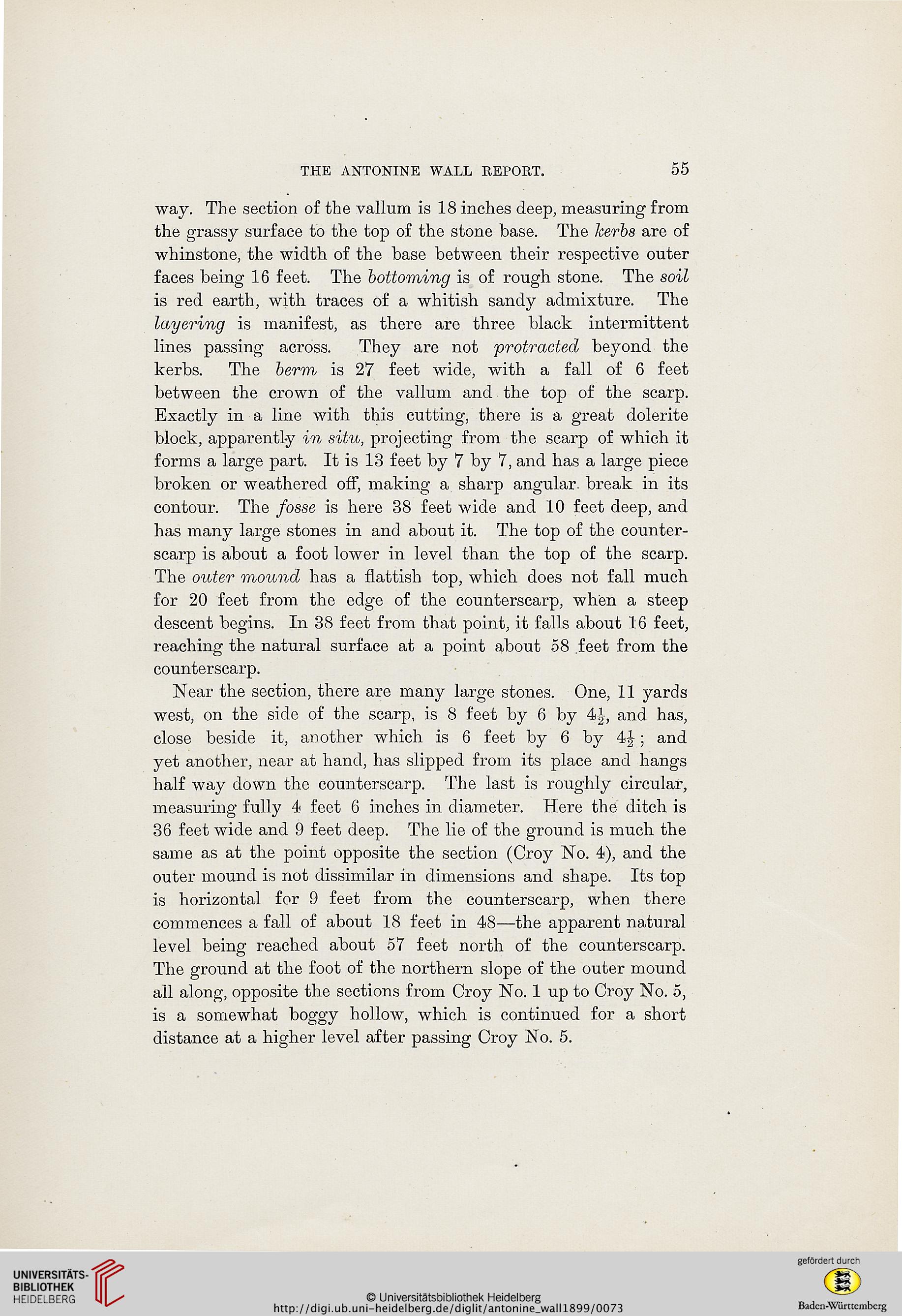THE ANTONINE WALL REPORT.
55
way. The section of the vallum is 18 inches deep, measuring from
the grassy surface to the top of the stone base. The kerbs are of
whinstone, the width of the base between their respective outer
faces being 16 feet. The bottoming is of rough stone. The soil
is red earth, with traces of a whitish sandy admixture. The
layering is manifest, as there are three black intermittent
lines passing across. They are not protracted beyond the
kerbs. The berm is 27 feet wide, with a fall of 6 feet
between the crown of the vallum and the top of the scarp.
Exactly in a line with this cutting, there is a great dolerite
block, apparently in situ, projecting from the scarp of which it
forms a large part. It is 13 feet by 7 by 7, and has a large piece
broken or weathered off, making a sharp angular, break in its
contour. The fosse is here 38 feet wide and 10 feet deep, and
has many large stones in and about it. The top of the counter-
scarp is about a foot lower in level than the top of the scarp.
The outer mound has a flattish top, which does not fall much
for 20 feet from the edge of the counterscarp, when a steep
descent begins. In 38 feet from that point, it falls about 16 feet,
reaching the natural surface at a point about 58 feet from the
counterscarp.
Near the section, there are many large stones. One, 11 yards
west, on the side of the scarp, is 8 feet by 6 by 4|, and has,
close beside it, another which is 6 feet by 6 by 4J ; and
yet another, near at hand, has slipped from its place and hangs
half way down the counterscarp. The last is roughly circular,
measuring fully 4 feet 6 inches in diameter. Here the ditch is
36 feet wide and 9 feet deep. The lie of the ground is much the
same as at the point opposite the section (Croy No. 4), and the
outer mound is not dissimilar in dimensions and shape. Its top
is horizontal for 9 feet from the counterscarp, when there
commences a fall of about 18 feet in 48—the apparent natural
level being reached about 57 feet north of the counterscarp.
The ground at the foot of the northern slope of the outer mound
all along, opposite the sections from Croy No. 1 up to Croy No. 5,
is a somewhat boggy hollow, which is continued for a short
distance at a higher level after passing Croy No. 5.
55
way. The section of the vallum is 18 inches deep, measuring from
the grassy surface to the top of the stone base. The kerbs are of
whinstone, the width of the base between their respective outer
faces being 16 feet. The bottoming is of rough stone. The soil
is red earth, with traces of a whitish sandy admixture. The
layering is manifest, as there are three black intermittent
lines passing across. They are not protracted beyond the
kerbs. The berm is 27 feet wide, with a fall of 6 feet
between the crown of the vallum and the top of the scarp.
Exactly in a line with this cutting, there is a great dolerite
block, apparently in situ, projecting from the scarp of which it
forms a large part. It is 13 feet by 7 by 7, and has a large piece
broken or weathered off, making a sharp angular, break in its
contour. The fosse is here 38 feet wide and 10 feet deep, and
has many large stones in and about it. The top of the counter-
scarp is about a foot lower in level than the top of the scarp.
The outer mound has a flattish top, which does not fall much
for 20 feet from the edge of the counterscarp, when a steep
descent begins. In 38 feet from that point, it falls about 16 feet,
reaching the natural surface at a point about 58 feet from the
counterscarp.
Near the section, there are many large stones. One, 11 yards
west, on the side of the scarp, is 8 feet by 6 by 4|, and has,
close beside it, another which is 6 feet by 6 by 4J ; and
yet another, near at hand, has slipped from its place and hangs
half way down the counterscarp. The last is roughly circular,
measuring fully 4 feet 6 inches in diameter. Here the ditch is
36 feet wide and 9 feet deep. The lie of the ground is much the
same as at the point opposite the section (Croy No. 4), and the
outer mound is not dissimilar in dimensions and shape. Its top
is horizontal for 9 feet from the counterscarp, when there
commences a fall of about 18 feet in 48—the apparent natural
level being reached about 57 feet north of the counterscarp.
The ground at the foot of the northern slope of the outer mound
all along, opposite the sections from Croy No. 1 up to Croy No. 5,
is a somewhat boggy hollow, which is continued for a short
distance at a higher level after passing Croy No. 5.




